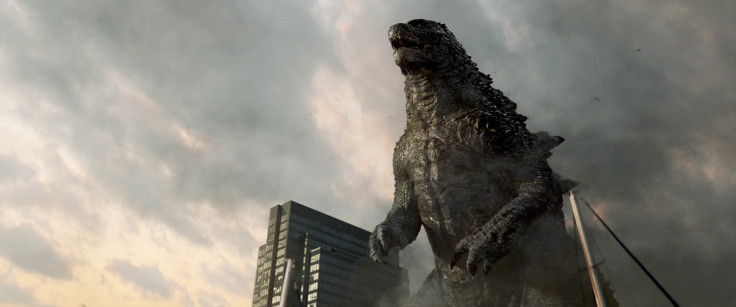'Godzilla' Review: Stomping On The Arrogance Of Man

Major real-life disasters of the last decade and a half are alluded to in Gareth Edwards’s “Godzilla” reboot, which comes 16 years after the last American attempt. Images of Fukushima, 9/11 and the 2004 tsunami, permanently etched into the global consciousness, are all woven into the sensational chaos of Godzilla's return.
Which makes it even more impressive that Edwards manages to make the devastation look so darn beautiful. At times, even characters in harm's immediate way often seem more awestruck than terrified. They're as consumed with eager anticipation as they are with dread.
Speaking of anticipation, Godzilla himself takes his time making an appearance. The film's first hour is concerned with another monster, the straightforwardly-named MUTO (Massive Unidentified Terrestrial Organism), who has until recently been nesting in the ruins of a Japanese power plant. MUTO, a winged creature who appears to feeds on nuclear bombs, has risen to unite with his mate and unleash many more MUTOs upon the earth.
The wobbly backstory takes us back to 1999: Joe Brody (Bryan Cranston) is a supervisor at the aforementioned power plant, where his wife, Sandra (Juliette Binoche), also works. On Joe's birthday, indeterminate seismic activity causes a radiation leak at the plant, and despite a desperate attempt to save her, Joe is ultimately forced to seal his wife inside a contaminated area, lest the radiation wipe out, presumably, a good chunk of humanity. Their young son, Ford, watches in horror on TV as the plant collapses. Not long before this, scientists Ichiro Serizawa (Ken Watanabe) and Vivienne Graham (Sally Hawkins) had been called to investigate the discovery of a giant creature's remains alongside active pods somewhere deep in the Philippines. Soon after, they realize one of the pods has hatched. This is not a coincidence.
Yet the 1999 disaster is blamed on an earthquake, and the plant has been quarantined as a radioactive site ever since. Joe, still mad with grief and guilt 15 years later, is convinced that the government covered up the true source of the disaster, and has been single-mindedly devoted to exposing the truth. A now-grown Ford (Aaron Taylor-Johnson) is a bomb-diffusing specialist in the Navy, living with his wife and young child in San Francisco. Long tired of his father's conspiracy theorizing, Ford just wants everyone to move on. He reluctantly travels to Japan when Joe is arrested for trespassing, and is becomes convinced in spectacular fashion that his father was on to something all these years.
From here on out, the Pacific Ocean and its major coastal cities are a battleground of man vs. beast, and beast vs. beast. This is where “Godzilla” shows it strength: The death of hordes of nameless strangers notwithstanding, the obliteration is magnificent to behold. Superbly executed special effects serve as a glorious reminder of the fragility of human life (and bridges and tall buildings.) As Serizawa says at one point, “The arrogance of man is thinking that nature is in their control and not the other way around.” Touché.
Max Borenstein and Dave Callahan's narrative doesn't trouble itself much with character development or expository dialogue – you're on your own to make sense of what exactly is happening, just like the inhabitants of San Franciso and Honolulu and Las Vegas are when the cities first erupt in chaos. While it's always nice to see Sally Hawkins, it's disappointing to watch her character in perpetual wide-eyed deference to her colleague, Watanabe's Serizawa. And the talents of Cranston and Elizabeth Olsen, who plays Ford's wife, have been put to far better use.
But that's not the point. The point is that Godzilla is a giant scaly monster who can wipe out a city skyline with a flick of his tail. Behold!
Indeed, much of the spectacular devastation is due to Godzilla’s immense size – he can't help but crush anything in his path. And if you’re not well-acquainted with him, it’s hard to know how much of the destruction he causes is intentional. When he’s not breathing fire, the monster can be hard to read.
Those new to the Godzilla franchise – or the monster movie genre in general – might find themselves a bit disoriented at points. Since when can you ride a helicopter from Japan to Hawaii? Why is there a penis-shaped disco ball in that cave? Which one is the bad guy?
Sooner or later (depending on how easily you can follow the narrative) it does become clear that Godzilla is also intent on preventing the MUTO mutation: With man and beast united against a common enemy, a happy ending can be granted to the surviving characters we (sort of) care about.
This “Godzilla” won't revolutionize the creature feature, and it doesn't try to prove that the monster movie is worth more than its weight in popcorn. But judged on the merits of awe-inspiring spectacle alone, “Godzilla” crushes it.
© Copyright IBTimes 2024. All rights reserved.






















